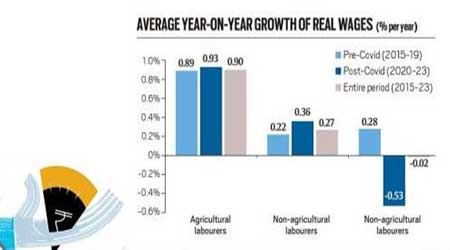Date: 25/05/2023
Relevance: GS-3: Indian Economy and issues relating to planning, mobilization, of resources, growth, development and employment.
Key Phrases: Stagnation, Labour Bureau, Non-Agricultural Laborers, Construction Workers, Informal-Sector Occupations, Centre for Labour Research and Action.
Context:
- Wage data collected by the Centre for Labour Research and Action
reveal a steady decline in real wages of brick-kiln workers in the last 10
years.
- Brick-kiln work is a fallback occupation for some of India’s poorest groups.
Introduction
- In recent years, there has been growing evidence suggesting a concerning
trend of stagnation in real wages for the poorest communities.
- Despite claims of rising wages, the data released by the Labour Bureau clearly demonstrates a lack of substantial growth.
- This article aims to shed light on the persistently low growth rates in real wages since 2014, particularly among agricultural labourers, non-agricultural labourers, and construction workers.
- By analyzing the available data and debunking flawed methodologies, it becomes evident that the poorest communities are facing significant challenges in improving their financial conditions.
About Stagflation
- Stagflation refers to a specific economic phenomenon characterized by a simultaneous increase in inflation, a decline in output, and a rise in unemployment.
- During periods of stagflation, it is common to observe a decrease in real incomes as wages struggle to keep pace with the rising prices.
- This economic situation is often triggered by a surge in commodity
prices, particularly oil, as seen in the stagflation of the 1970s
when oil prices tripled.
- A similar scenario occurred in 2008 following the global recession and the spike in oil prices.
- The complexity of stagflation poses a challenge for policymakers who face a dilemma: they can either increase interest rates to combat inflation or lower interest rates to alleviate unemployment.
Examining the Data
- The analysis of the Labour Bureau data reveals an alarming trend
in the growth rates of real wages.
- Between 2014-15 and 2022-23, the growth rates for male agricultural laborers, non-agricultural laborers, and construction workers were significantly below 1 percent per year.
- In fact, the growth rates were merely 0.8 percent, 0.2 percent, and slightly negative, respectively.
- These figures have been derived from semi-log regression models, which have been replicated by other researchers and even used by the finance ministry for training sessions on macroeconomic diagnostics.
- Even for those averse to statistical methods, a simple observation of the graph of real wages confirms the lack of substantial growth.
Flawed Methodologies
- Critics who claim that real wages have been rising often employ flawed
methodologies that fail to accurately represent the true situation.
- For instance, the unpack-repack method, which aggregates unweighted averages over months and population-weighted averages over states, does not yield accurate results.
- This flawed approach can be illustrated by a simple example where the growth rate of wages between two years is zero, but the unpack-repack method erroneously calculates an 8.3 percent per year growth rate.
- To obtain accurate growth rates, wages should be analyzed on an annual basis, as demonstrated in the original analysis, which showed growth rates of 2.2 percent, 1.4 percent, and 1.3 percent for male agricultural laborers, non-agricultural laborers, and construction workers, respectively, during the period of 2014-15 to 2018-19.
Expanding the Analysis
- The evidence of near-stagnation in real wages extends beyond the three
occupation groups mentioned earlier.
- The Labour Bureau data includes information on several informal-sector occupations, and an ongoing study by the Foundation for Agrarian Studies reveals that the trend growth rates for most of these occupations are below 1 percent per year.
- Only two occupations, picking and horticulture for women, show growth
rates above 2 percent per year, and even these figures are based on
incomplete data.
- When extended to 2022-23, the series is expected to present an even bleaker picture.
Corroborating Evidence:
- Corroborating evidence from various sources further supports the claim of near-stagnation in real wages for the poorest communities.
- The Centre for Labour Research and Action has collected wage data
that indicates a steady decline in real wages for brick-kiln workers over
the past decade.
- This decline is particularly concerning as brick-kiln work serves as a fallback occupation for some of India's most impoverished communities.
- Such a decline in real wages has not been observed for a significant period, accentuating the severity of the situation.
Conclusion:
- The analysis of Labour Bureau data and corroborating evidence from various sources paints a distressing picture of the state of real wages for the poorest communities in India.
- Despite claims of rising wages, the evidence clearly indicates a
near-stagnation in real wage growth since 2014.
- The flawed methodologies used by critics fail to capture the true extent of the problem, while accurate analysis reveals consistently low growth rates.
- Urgent measures are required to address this issue and uplift the
economic conditions of the most vulnerable segments of society.
- Failure to do so may perpetuate inequality and hinder progress towards a more inclusive and equitable society.
Source: The Indian Express
Mains Question:
Q. Discuss the concept of stagflation and its implications for policymakers in addressing the simultaneous challenges of inflation and unemployment. (50 words)







